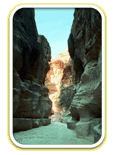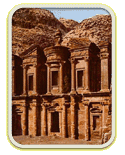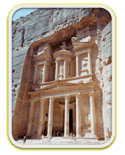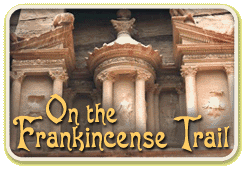 |
 |
 |
|
|||
|
On The Frankincense Trail One of the most spectacular sites along the frankincense trail is the ancient city of Petra, a vast complex of magnificent shrines and tombs carved into sandstone cliffs by the Nabataens, an Arabic people who settled in what is now southern Jordan in the 4th century B.C. Completely surrounded by mountains, Petra remaimed a forgotten city after its fall in the first century A.D., known only to Beduoin squatters who considered the place sacred and off-limits to outsiders. But in 1812, a resourceful Swiss explorer, disguising himself as an Arab, tricked the locals into showing him the secret entrance to Petra - a narrow, winding, mile-long cleft in the mountains called the Siq. 
Kamel: "Now we be started walking through the siq . . ." A couple of centuries later, the inevitable - tourists. Some three to four thousand a day now snake their way through the Siq. They come to gawk at the imposing Greco-Roman facades of Petra's tombs, and to marvel at the legacy of these enterprising people who forged an empire. This empire was forged not with armies, but with the cash receipts from trade in frankincense - the pebbly, dried sap of the frankincense tree, treasured by the ancients as an aromatic.
Kamel: "Before that, they were actually attacking the caravans, plundering them." Local guide, Kamel Jayusi.
Kamel: "But when they came here, they thought why not like receiving the caravans, providing them with food and water and take taxes or tolls from them." Those taxes and tolls amounted to about $900 million a year. There wasn't any way around them either, because if you were a spice merchant who wanted to get your product from point A (that is southern Arabia where frankincense comes from) to point B (the major markets in the Mediterranean), you had to go through these mountains. That meant going through Petra. 
Keen businessmen, the Nabateans soon expanded their empire, and thereby their monopoly on the camel caravans, into what is now northwestern Saudi Arabia. This is where they built cities like Madain Saleh, a lonely outpost on edge of Nefud Desert and an architectural carbon copy of Petra. In the desert, water means eveything, and the Nabateans were masters at channeling it from the mountain tops during the rainy season into dams and cisterns still used today by traveling Beduoin. And while they were removed some 25 centuries from the age of the dot.com, the Nabateans had pretty sophisticated information networks of their own. Saad al-Juraid is a guide with PVA Travel planning, one of the first US tour operators to offer trips to Saudi Arabia.
Saad: "They used to have like reporters whose coming from all over and they come with the caravans of incense and spices and silk and if you want to get the news, you have to come that day, otherwise you are up creek without a paddle." The fact that the Nabateans pulled all these strings without drawing any swords continues to impress historians. During the first century A.D., keeping Roman legions out of your back yard wasn't so easy. The Nabateans managed to do so by buying them off.
McColl: "No spears, no weapons. It was all done with money." University of Kansas geography professor Robert McColl says history is full of cases where Nabatean-style diplomacy has saved the day.
McColl: "I don't think Monoco was ever shelled during the entire second world war, and there it sits between Italy and France and the answer was probably, you know, we're paying for your war, and we won't if you bomb my palace." 
But this policy could only last so long. With the same sort of obsequious envy the west now reserves for oil-rich Gulf states, the Romans began to explore ways to do an end-run around the frankincense-rich Nabateans. The sea provided the answer, and an alternative route to the frankincense groves of southern Arabia. Suddenly out of business, the Nabateans were absorbed by the Roman empire and disappeared as a people, victims of the very economy they'd helped to create. But according to some, they've not disappeared entirely. Here at Petra, local Beduoin claim they're the descendents of the Nabateans. Though they were relocated from the ruins of the city to nearby government housing twenty years ago, they sweetened the deal by negotiating exclusive rights to operate all the shops, camels rides, and other tourist business within the site.
Kamel: "They know how to make money." Again local guide Kamel Jayusi.
Kamel: "And when you see them making a bargain, selling something, you think, yes they are as skillful as their ancestors." On the frankincense trail in Petra, Jordan, I'm Tom Verde for the Savvy Traveler. Air transportation and accommodations in Jordan provided by Jordan Tourism Board.
{ On the Frankincense Trail: Part One | Part Two | Part Three | Part Four | Part Five }
|
 | American Public Media Home | Search | How to Listen ©2004 American Public Media | Terms of Use | Privacy Policy |
